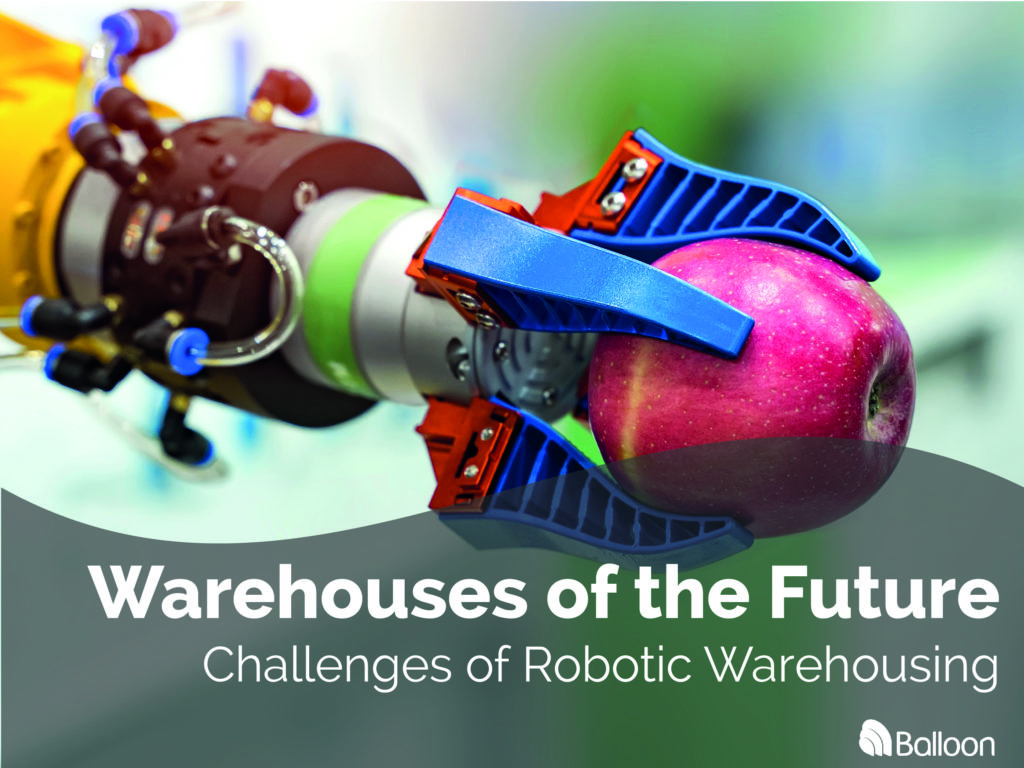Warehouses of the Future: Challenges of Robotic Warehousing.
Blog Post by Claire Kerr
Introducing robots in the warehouse brings greater productivity and cost savings. But there are some jobs that robots just can’t do – at the moment, at least. Overcoming these challenges would bring about a revolutionary change in warehousing. But are they insurmountable? Is robotic warehousing possible? Or are the challenges so great that robots won’t ever be able to completely replace humans?
Here, we look at the processes in warehousing and examine what tasks robots can already do, and where they might successfully compete with humans in the future.

Receipt.
Receiving goods could theoretically be automated. You could set up a system that scans incoming receipts and adds the goods automatically to the inventory via a Warehouse Management System (WMS).
But robots can only operate within certain tolerances, or to a pre-programmed approach. The minute there’s a slight deviation – a damaged pallet or an inconsistently placed label – then the robot can’t work with that. So it needs a human to supervise and oversee the process. Human input is needed to handle the broken pallet in a different way, or to orient the delivery the right way for the scanner to be able to capture the barcoded label.
Putaway and moving goods.
There are already a number of robotic solutions that help with putaway, storage and retrieval, and the movement of goods around the warehouse.
This is one area that robots excel at and which can limit human exposure to risk. Robots can carry and transport heavier goods than we can. They can retrieve goods from high places without needing safety harnesses. And they can do it all day in, day out, without getting tired.
Automated Storage and Retrieval Systems (ASRS) and Automated Guided Vehicle (AGVs) can bring a whole rack of goods to a picker. And self-guided, self-propelling robots can move goods around the warehouse with ease.
Picking.
Warehouse machinery like carousels and conveyors can effectively be controlled by a Warehouse Control System (WCS) to automate the picking process and bring items directly to pickers.
In this way, robots can work together with humans to form a semi-automated solution that speeds up picking. Locus Robotics, for example, has a robotic warehousing solution that integrates with HighJump WMS software:
But robots struggle when it comes to the picking itself. With regularly-shaped or flat-sided goods, suction cups can work to pick and release products.
And with irregular objects, a grasper can be used. But it’s seems it’s almost impossible to get a robot to successfully pick up everything.
Amazon found this. They stock such a wide range of different goods, in all sorts of shapes and sizes. They recognised the difficulties that robots have with handling unpredictable objects. The classic here is a bag of fruit, like oranges. When picked up, the bag will not always handle the same way. A human can recognise this and adapt. But a robot can only respond according to its pre-programming.
To answer this picking challenge, Amazon ran a competition. Called the Amazon Robotics/Picking Challenge, it ran from 2017 for a few years. It challenged groups to create robotic warehousing systems that would address picking and help automate it at scale.
This is the 2018 winner in action:
These days, Amazon has a wholly-owned subsidiary, Amazon Robotics that is continually “reimagining now”, as they put it. It develops solutions to make order fulfilment faster and more efficient. It is using machine learning, object recognition and depth sensing to further develop autonomous mobile robots and to create the software to control them.
Packing and dispatch.
Case packing and palletising solutions are a mainstay in manufacturing and have been around for many years now.
But they are typically used to mass pack items or cases of the same size and weight. So the challenge again here is when it comes to varying sizes and weights of package, like you’d have in a multi-product warehouse. Where no two customer’s orders are the same, then different packaging sizes or types will be needed. It’s here, therefore, that human input is still vital.
Where the final cartons for delivery are uniform in size, then automation can be used to affix delivery labels and stack orders ready for transportation though.
So could robots ever replace humans?
Robots are ideal for taking on the laborious, hazardous or heavy work that humans prefer not to do. And technological innovation by the likes of Ocado and Amazon is already revolutionising the warehouse to enable this. But is robotic warehousing a reality? Could robots really take over the full order fulfilment process in a warehouse, and replace humans entirely?
Picking and packing seem to be the most problematic parts of the order fulfilment process. They require some level of human input. If a warehouse only shipped the same goods, in units of one, then it’s eminently possible that a robot could be devised that would pick, pack and ship those items. But as this is not the norm for the vast majority of warehouses, it just doesn’t seem that it will transpire.
It’s humans that create robots. And humans are needed to be able to programme the robots in the right way. To work successfully, humans and robots must work together. But ultimately, it’s the humans that are in control. And until robots can compete like for like with a human in creative thinking, decision-making and ingenuity, then robots will always be the servants, not the masters.